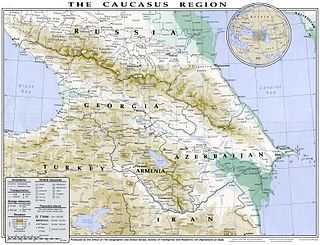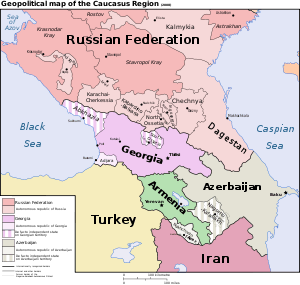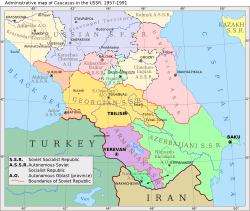South Caucasus

The South Caucasus is a geopolitical region located on the border[1] of Eastern Europe[2] and Southwest Asia[3][4][5][6] also referred to as Transcaucasia, or The Trans-Caucasus. More specifically, the South Caucasus area spans the southern portion of the Caucasus Mountains and its lowlands, straddles the border between the two continents of Europe and Asia, extends from the southern part of the Greater Caucasus mountain range of southwestern Russia southerly to the Turkish and Armenian borders, and from the Black Sea to the Caspian Sea coast of Iran. The area includes the southern part of the Greater Caucasus Mountain range, the entire Lesser Caucasus Mountain range, the Colchis Lowlands and Kura-Aras Lowlands, the Talysh Mountains, the Lenkoran Lowlands, Javakheti and the eastern portion of the Armenian Highland. The Transcaucasus, or South Caucasus area, is a part of the entire Caucasus geographical region that essentially divides the Eurasian transcontinent into two.
All of Armenia is in Southern Caucasus; the majority of Georgia and Azerbaijan, including the exclave of Nakhchivan, fall within this area. The countries of the region are producers of oil, manganese ore, tea, citrus fruits, and wine.
In Western languages, the terms Transcaucasus and Transcaucasia are translations of the Russian zakavkazie meaning "the area beyond the Caucasus Mountains", i.e., as seen from the Russian capital (analogous to the Roman terms Transalpine and Transpadana). The region remains one of the most complicated in the post-Soviet area, and comprises three heavily disputed areas – Abkhazia and South Ossetia in Georgia, and Nagorno-Karabakh Republic recognised only by three other non-UN states. Several wars, including the 2008 South Ossetia war, Georgian–Ossetian conflict, and the Nagorno-Karabakh war have been waged in this region.
History


Located on the peripheries of Turkey, Iran and Russia, the region has been an arena for political, military, religious, and cultural rivalries and expansionism for centuries. Throughout its history, the region has come under control of various empires, including amongst others, the Romans, Byzantine, Mongol, Persian, Ottoman and Russian, all of which introduced their faiths and cultures.[7]
Ancient kingdoms of the region included Armenia, Albania, and Iberia, among others. These kingdoms were later incorporated into various Iranian empires, including Achaemenid Empire, Parthian Empire, Sassanid Empire, during which Zoroastrianism became the dominant religion in the region. However, after the rise of Christianity and conversion of Caucasian kingdoms to the new religion, Zoroastrianism lost its prevalence and only survived because of Persian power and influence still lingering in the region. Thus South Caucasus became the area of not only military, but also religious convergence, which often led to bitter conflicts with successive Persian Empires on the one side and the Roman (later Byzantine) Empire on the other.
In the middle of the 8th century, with the capture of Derbend by the Umayyad armies, most of the South Caucasus became part of the Caliphate and Islam spread throughout the region.[8] In the middle centuries, Kingdom of Georgia dominated the most of South Caucasus. The region was later conquered by the Seljuks, Mongols, Turkic, Safavid and the Ottoman dynasties.
After two wars in the beginning of 19th century, the Russian Empire had finally conquered the South Caucasus from the Qajars severing historic regional ties with Iran.[9] After the fall of Russian Empire in 1918, the region was unified into a single political entity twice: as Transcaucasian Democratic Federative Republic from 9 April 1918 to 26 May 1918, and as Transcaucasian Socialist Federative Soviet Republic from 12 March 1922 to 5 December 1936.
Transcaucasia, in particular where modern day Georgia and Armenia are located, is one of the native areas of the wine-producing vine Vitis vinifera. Some experts speculate that it may be the birthplace of wine production.[10] Archaeological excavation and carbon dating of grape pips from the area have dated back to 7000–5000 BC.[11]
See also
- Caucasus
- Caucasus Greeks
- North Caucasus (Ciscaucasia)
- Ibero-Caucasian languages
- Peoples of the Caucasus
References
- ↑ CIA World Factbook (May 2006). "Caucasus". Library of Congress. Retrieved 7 July 2009.
- ↑ Mulvey, Stephen (16 June 2000). "The Caucasus: Troubled borderland". News. BBC. Retrieved 1 July 2009. ""The Caucasus Mountains form the boundary between West and East, between Europe and Asia...""
- ↑ Georgia, from Foreign and Commonwealth Office
- ↑ Georgia, from Encarta
- ↑ Georgia, from Intute
- ↑ Georgia, from National Geographic
- ↑ German, Tracey (2012). Regional Cooperation in the South Caucasus: Good Neighbours Or Distant Relatives?. Ashgate Publishing Ltd. p. 44. ISBN 1409407217.
- ↑ King, Charles (2008). The Ghost of Freedom: A History of the Caucasus. Oxford University Press. p. 65. ISBN 0199884323.
- ↑ Multiple Authors, "Caucasus and Iran" in Encyclopaedia Iranica
- ↑ Hugh Johnson Vintage: The Story of Wine pg 15 Simon & Schuster 1989
- ↑ Ibid. pg 17
External links
| Wikimedia Commons has media related to Transcaucasus (South Caucasus). |
- Caucasian Review of International Affairs - an academic journal on the South Caucasus
- Caucasus Analytical Digest - Journal on the South Caucasus
- Transcaucasia (The Columbia Encyclopedia article)